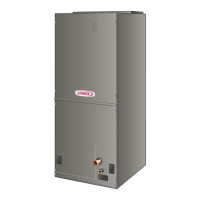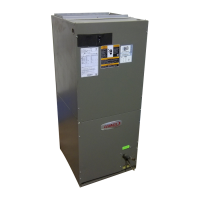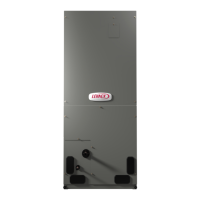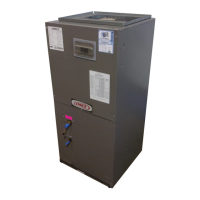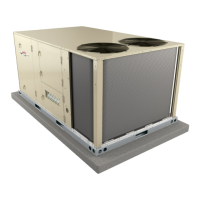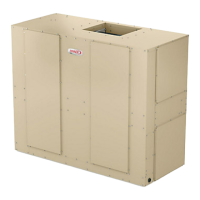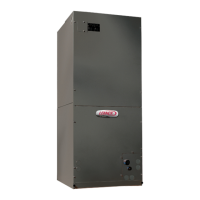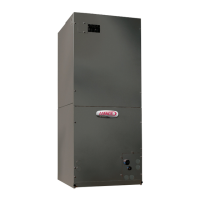Page 18
Check-out Procedures
NOTE – Refer to outdoor unit installation instructions for sys-
tem start-up instructions and refrigerant charging instructions.
PRE-START-UP CHECKS
• Is the air handler properly and securely installed?
• If horizontally congured, is the unit sloped up to 5/8
inch toward drain lines?
• Will the unit be accessible for servicing?
• Has an auxiliary pan been provided under the unit with
separate drain for units installed above a nished ceil-
ing or in any installation where condensate overow
could cause damage?
• Have ALL unused drain pan ports been properly
plugged?
• Has the condensate line been properly sized, run,
trapped, pitched, and tested?
• Is the duct system correctly sized, run, sealed, and in-
sulated?
• Have all cabinet openings and wiring been sealed?
• Is the indoor coil factory-installed TXV properly sized for
the outdoor unit being used?
• Have all unused parts and packaging been disposed
of?
• Is the lter clean, in place, and of adequate size?
• Is the wiring neat, correct, and in accordance with the
wiring diagram?
• Is the unit properly grounded and protected (fused)?
• Is the thermostat correctly wired and in a good location?
• Are all access panels in place and secure?
CHECK BLOWER OPERATION
• Set thermostat to FAN ON.
• The indoor blower should come on.
CHECK COOLING OPERATION
• Set thermostat to force a call for cooling (approximately
5ºF lower than the indoor ambient temperature).
• The outdoor unit should come on immediately and the
indoor blower should start between 30 - 60 seconds lat-
er.
• Check the air ow from a register to conrm that the
system is moving cooled air.
• Set the thermostat 5ºF higher than the indoor tempera-
ture. The indoor blower and outdoor unit should cycle
o.
CHECK ELECTRIC HEAT (IF USED)
• Set thermostat to call for auxiliary heat (approximate-
ly 5°F above ambient temperature). The indoor blow-
er and auxiliary heat should come on together. Allow a
minimum of 3 minutes for all sequencers to cycle on.
• Set the thermostat so that it does not call for heat. Allow
up to 5 minutes for all sequencers to cycle o.
Operation
Cooling (Cooling Only or Heat Pump)
On all models, the 24 volt line will go directly to the termi-
nal board from the transformer. The normally open con-
tacts close, causing the indoor blower motor to operate;
depending on the indoor blower motor, there may be a
delay. The circuit between R and Y is completed, closing
the circuit to the contactor in the outdoor unit, starting the
compressor and outdoor fan motor.
On heat pumps, circuit R and O energizes the reversing
valve, switching the valve to the cooling position. (The re-
versing valve remains energized as long as the thermo-
stat selector switch is in the COOL position.)
At the completion of the cooling demand, the indoor blow-
er and outdoor unit should cycle o. Air handler should
cycle o 45 seconds after the outdoor unit shuts o.
Heating (Electric Heat Only)
When the thermostat calls for heat, the circuit between R
and W is completed, and the heat sequencer is energized.
A time delay follows before the heating elements and the
indoor blower motor come on. Units with a second heat
sequencer can be connected with the rst sequencer to W
on the thermostat sub-base, or they may also be connect-
ed to a second stage on the sub-base.
Heating (Heat Pump)
On all models, the 24 volt line will go directly to the termi-
nal board from the transformer. The normally open con-
tacts close, causing the indoor blower motor to operate;
depending on the indoor blower motor, there may be a
delay. The circuit between R and Y is completed, closing
the circuit to the contactor in the outdoor unit, starting the
compressor and outdoor fan motor.
If the room temperature continues to decrease, the cir-
cuit between R and W1 is completed by the second-stage
heat room thermostat. Circuit R-W1 energizes a heat se-
quencer. The completed circuit will energize supplemen-
tal electric heat (if applicable). Units with a second heat
sequencer can be connected with the rst sequencer to
W1 on the thermostat. They may also be connected to
a second heating stage W2 on the thermostat sub-base.
Emergency Heat (Heating Heat Pump)
If the selector switch on the thermostat is set to the emer-
gency heat position, the heat pump will be locked out of
the heating circuit, and all heating will be electric heat (if
applicable). A jumper should be placed between W2 and E
on the thermostat sub-base so that the electric heat con-
trol will transfer to the rst-stage heat on the thermostat.
This will allow the indoor blower to cycle on and o with
the electric heat when the fan switch is in the AUTO po-
sition.
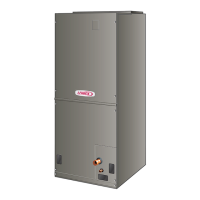
